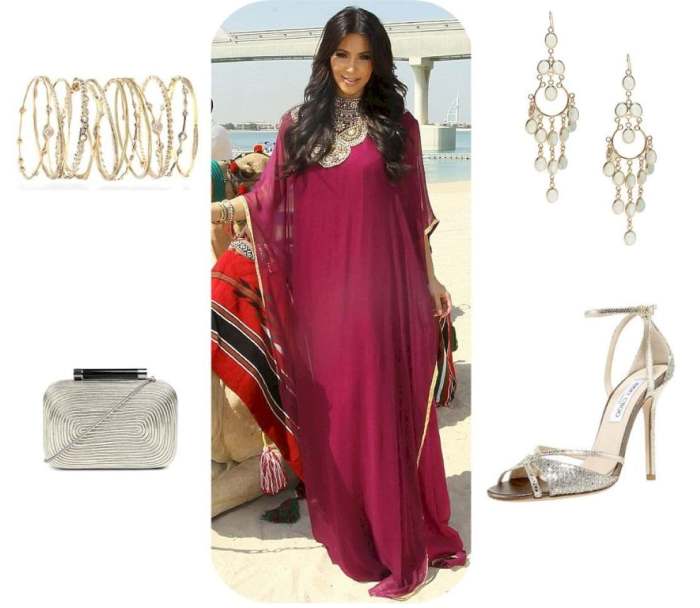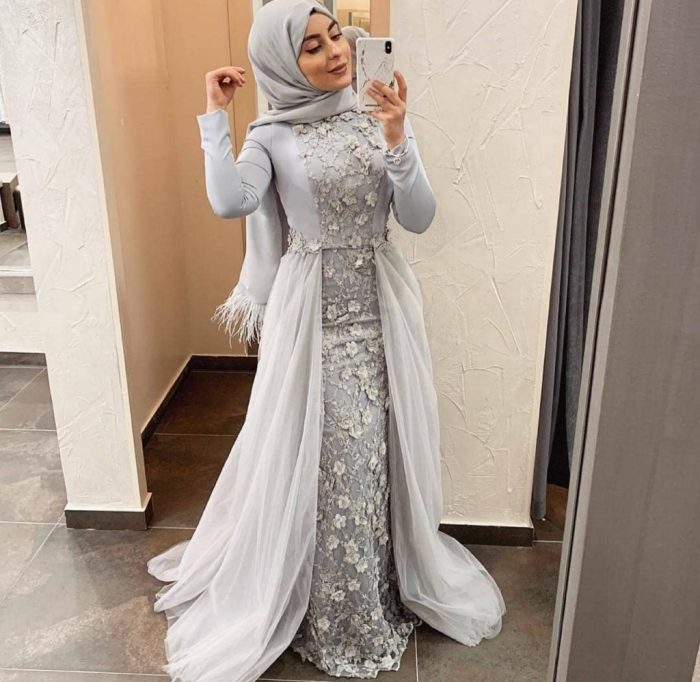Arab Wedding Guest Dress Styles
Attending an Arab wedding is a vibrant and culturally rich experience, and choosing the right attire is crucial to show respect and participate gracefully. This guide explores the diverse world of Arab wedding guest dresses, covering styles, fabrics, accessories, etiquette, and modern interpretations.
Dress Styles for Arab Weddings
Arab wedding guest dresses showcase a beautiful blend of tradition and modernity. Popular styles vary significantly across different Arab countries and even within families, reflecting the region’s diverse cultural heritage. Traditional styles often incorporate flowing fabrics and modest silhouettes, while modern interpretations embrace contemporary cuts and embellishments while maintaining cultural sensitivity.
Traditional and Modern Arab Wedding Guest Dress Styles: A Comparison
Traditional Arab wedding guest dresses often feature floor-length gowns, long sleeves, and modest necklines. Fabrics like silk, brocade, and velvet are common. Modern interpretations may maintain the elegance of traditional styles but incorporate shorter hemlines, more fitted silhouettes, and contemporary embellishments like sequins or beading. The key difference lies in the level of embellishment and the overall silhouette, with modern styles often showcasing a more streamlined and contemporary aesthetic while retaining an element of cultural respect.
Variations in Dress Styles Across Arab Countries

Source: sandiegotowingca.com
Choosing an Arab wedding guest dress often involves considering cultural nuances and appropriate levels of formality. A popular and stylish option that balances elegance and comfort is a two-piece ensemble; for inspiration and ideas, check out this selection of 2 piece dresses for wedding guest. Ultimately, the best Arab wedding guest dress will reflect your personal style while respecting the celebratory occasion.
Dress styles vary considerably across different Arab countries. For instance, Moroccan wedding attire might feature vibrant colors and intricate embroidery, while those in the Gulf region may favor more subdued tones and luxurious fabrics. Egyptian styles might incorporate bolder colors and unique cuts, reflecting the country’s distinctive fashion sense. Understanding these regional differences helps guests choose an outfit that is both respectful and stylish.
| Style | Description | Occasion | Image Description |
|---|---|---|---|
| Kaftan | A long, loose-fitting robe, often adorned with intricate embroidery or embellishments. | Formal wedding, daytime or evening | A flowing, floor-length kaftan in deep emerald green silk, featuring delicate gold embroidery around the neckline and cuffs. The fabric drapes beautifully, creating a regal and elegant silhouette. |
| Jellaba | A long, hooded cloak, typically worn over other clothing. | More formal, conservative weddings, particularly in some Gulf countries. | A simple, yet elegant, black jellaba in a lightweight wool fabric, with subtle embroidery along the collar and cuffs. The long, flowing lines create a modest and graceful look. |
| Abaya | A long, loose-fitting cloak, often black, worn by women in many Arab countries. | Weddings where a more modest dress code is preferred. | A classic black abaya in a luxurious crepe fabric, featuring subtle embellishments along the edges and a simple, elegant cut. The fabric drapes smoothly, creating a sophisticated and modest silhouette. |
| Modern Gown | A floor-length or midi-length gown in a contemporary style, potentially featuring embellishments or unique cuts. | Most weddings, offers flexibility. | A sleek, floor-length gown in a rich burgundy color, made of a luxurious velvet fabric. The gown features a high neckline, long sleeves, and a fitted bodice, complemented by a flowing skirt. Minimal, yet elegant embellishments add sophistication. |
Fabrics and Colors
The choice of fabric and color significantly impacts the overall impression of an Arab wedding guest dress. Certain fabrics and colors hold cultural significance, influencing the selection process. Understanding these nuances ensures respectful and appropriate attire.
Commonly Used Fabrics in Arab Wedding Guest Dresses
Luxurious fabrics like silk, velvet, brocade, chiffon, and crepe are frequently used in Arab wedding guest dresses. These fabrics lend an air of elegance and sophistication, appropriate for the celebratory nature of the occasion. The choice of fabric often reflects the formality of the event and the personal preference of the guest.
Cultural Significance of Colors in Arab Wedding Attire
Color symbolism varies across different Arab cultures. However, rich jewel tones like emerald green, sapphire blue, ruby red, and gold are generally considered auspicious and elegant. These colors often represent prosperity, joy, and celebration. Subdued tones like ivory, beige, and pastels can also be appropriate, particularly for daytime events.
Color Appropriateness Based on Formality and Time of Year
Deeper, richer colors are generally preferred for evening weddings or more formal events. Lighter colors are often suitable for daytime weddings or less formal occasions. The time of year can also influence color choices; lighter shades might be preferable for warmer months, while darker tones suit cooler seasons.
A Suitable Color Palette for an Arab Wedding Guest Dress
A sophisticated color palette for an Arab wedding guest dress might include deep emerald green as the primary color, complemented by gold accents in jewelry or embroidery. This combination reflects elegance and prosperity, while remaining culturally sensitive and appropriate for most occasions. Alternatively, a rich sapphire blue with silver accents offers a similarly elegant and appropriate choice.
Accessories and Jewelry
Accessories and jewelry play a vital role in completing an Arab wedding guest look. Traditional and modern pieces add a personal touch and can enhance the overall elegance of the outfit. Careful selection ensures the accessories complement the dress without overshadowing it.
Examples of Traditional and Modern Accessories
Traditional accessories might include intricately designed belts, ornate headpieces (depending on cultural norms and personal preference), and delicate jewelry crafted from gold or silver. Modern accessories can include statement earrings, elegant clutches, or stylish belts that add a contemporary touch while still complementing the overall look.
Significance of Specific Jewelry Pieces

Source: emasscraft.org
In many Arab cultures, jewelry holds significant symbolic meaning. For example, gold jewelry often represents wealth and prosperity, while certain gemstones might symbolize specific virtues or good fortune. Understanding these cultural nuances adds depth to the accessory choices.
Accessories to Complement Different Dress Styles
A flowing kaftan might be complemented by a statement necklace and earrings, while a more modern gown could be paired with a sleek clutch and delicate bracelets. The key is to choose accessories that enhance the overall look without overwhelming it.
Step-by-Step Guide to Choosing the Right Accessories
- Consider the dress style and color.
- Select jewelry that complements the dress without clashing.
- Choose accessories that reflect the formality of the event.
- Ensure the accessories are comfortable and easy to wear.
- Prioritize quality over quantity.
Etiquette and Dress Code
Understanding the unspoken rules of dress for Arab weddings is essential for showing respect and cultural sensitivity. Dress codes can vary based on family traditions and the wedding’s location, so observing local customs is crucial.
Dress Code Variations Based on Tradition and Location
Some families may prefer more modest attire, while others may be more open to contemporary styles. Rural weddings may have different expectations compared to city weddings. Observing the overall atmosphere and the attire of other guests can provide valuable clues.
Appropriate and Inappropriate Attire
Generally, modest and elegant attire is appropriate. Avoid anything too revealing or casual. Clothing that is overly tight, short, or transparent is generally considered inappropriate. Respectful attire demonstrates consideration for the cultural context.
Dos and Don’ts Regarding Attire at an Arab Wedding
- Do: Choose elegant and modest attire. Opt for rich fabrics and jewel tones. Consider cultural norms.
- Don’t: Wear anything too revealing or casual. Avoid bright, attention-grabbing colors (unless appropriate for the specific culture). Refrain from wearing anything that could be considered disrespectful.
Finding the Perfect Dress
Finding the perfect dress involves careful planning and consideration of various factors. A systematic approach ensures you choose an outfit that is both appropriate and stylish.
Step-by-Step Guide for Choosing an Appropriate Dress, Arab wedding guest dress
- Review the wedding invitation for clues about the formality.
- Set a budget.
- Research different styles appropriate for Arab weddings.
- Shop online or in-store, comparing options.
- Consider comfort and ease of movement.
- Try on different styles to find the best fit.
Comparison of Online and Offline Shopping Options
Online shopping offers convenience and a wide selection, but requires careful consideration of sizing and fabric quality. In-store shopping allows for trying on dresses and getting personalized advice but may have a more limited selection.
Checklist for Finding the Perfect Dress
- Budget
- Style
- Comfort
- Fabric
- Color
- Appropriate level of formality
Determining the Appropriate Level of Formality

Source: zahrahrose.com
The wedding invitation often provides clues about the level of formality. Formal invitations may suggest a more elegant and traditional dress code, while less formal invitations may allow for more contemporary styles.
Modern Interpretations of Traditional Styles
Modern designers are creatively reinterpreting traditional Arab wedding guest dress styles, blending cultural heritage with contemporary aesthetics. This fusion creates unique and stylish pieces that respect tradition while embracing modern fashion trends.
Reinterpretations of Traditional Styles in Modern Fashion
Many designers are incorporating traditional embroidery techniques, silhouettes, and color palettes into modern designs. This results in dresses that are both contemporary and culturally relevant, offering a fresh perspective on traditional styles.
Use of Traditional Embroidery Techniques in Modern Designs
Traditional embroidery techniques, such as those found in Moroccan kaftans or Palestinian thobes, are being incorporated into modern gowns and dresses, adding a unique and culturally significant element to contemporary designs.
Modern Interpretation of a Traditional Arab Wedding Guest Dress
Imagine a floor-length gown in a deep teal silk, featuring a modern A-line silhouette. The neckline is elegantly simple, but the sleeves are long and slightly flared, reminiscent of traditional styles. Delicate gold embroidery, inspired by traditional patterns, is subtly incorporated around the neckline and cuffs, adding a touch of cultural heritage to the contemporary design. The fabric drapes beautifully, creating a sophisticated and elegant silhouette suitable for a modern Arab wedding.
Top FAQs: Arab Wedding Guest Dress
What is the typical dress code for an Arab wedding?
Dress codes vary widely, depending on the family’s traditions and the region. Generally, modest and respectful attire is preferred. However, some weddings may have a more formal or informal dress code.
Can I wear a jumpsuit or pantsuit to an Arab wedding?
While long dresses are common, modest jumpsuits or pantsuits in elegant fabrics are often acceptable, particularly if the wedding is less formal. Ensure the outfit is respectful and covers the shoulders and knees.
What if I don’t know the family’s traditions?
If unsure, it’s always best to err on the side of caution and choose a more conservative and elegant outfit. You can also subtly inquire with a close friend or family member attending the wedding for guidance.
Where can I find suitable dresses?
Both online retailers and local boutiques specializing in Middle Eastern or modest fashion offer a wide selection of appropriate dresses. Consider browsing websites and stores catering to special occasion attire.
